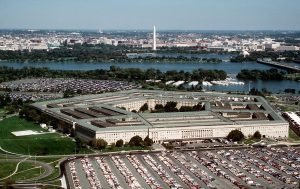When the Department of Defense (DoD) undergoes strategic change, allies and partners would benefit greatly from not only paying attention, but reading between the lines and playing a constructive shaping role. Even small changes in how DoD does business in Asia can lead to big implications for the strategies and defense investments of allies and partners.
Since 2014, the Pentagon’s most senior officials—former Secretary Chuck Hagel, Deputy Secretary Bob Work, and now Secretary Ash Carter—have delivered numerous speeches expounding on what they describe as a “third offset strategy.” Although many seem interested, there is remarkably little public discourse or debate among Asian allies and partners about the third offset.
I can think of three plausible reasons for the lack of such discussion among Asian allies and partners (including their citizens): they are wholly reassured by DoD’s efforts to regain military-technical superiority; they don’t see changes in U.S. weapons investments, doctrine, or force posture as having an impact on them; or ignorance—they don’t know what the Pentagon is talking about once the hyphenated word “military-technical” is introduced and subsequently don’t know what questions to ask or what issues to debate. The former two explanations, that they’re confidently assured and that they think it’s irrelevant, seem far less likely than the latter.
More in-depth historical context is offered here and here, but the important thing to know is that past offset strategies involved explicit decisions to leverage a U.S. technological advantage to help address strategically significant vulnerabilities to U.S. military operations. The first offset strategy (in the 1950s) leveraged U.S. nuclear superiority to address the Soviet Union’s numerical advantage in conventional ground forces in Europe, while the second offset (in the 1970s) leveraged a suite of U.S.-monopolized technologies to enable long-range precision-strike weapons, which addressed the Soviet Union’s nuclear parity as its nuclear arsenal caught up with the U.S. lead. Now, the basic problem is power projection amidst proliferating anti-access weapons and doctrines. I’m sure the Pentagon primarily thinks about China in this regard, but they’re far from the only one developing the ability to check the power projection capabilities of others.
So for Asian states who see the United States as important to their security, the following questions and answers are intended to help them understand what the Pentagon is thinking, where it might be headed, and what it might mean for them.
Isn’t the third offset strategy all about China?
Yes and no. The third offset is all about military-technical advantage, and the greatest threat to that is currently the spread of anti-access capabilities. China looks to be the most capable anti-access military, which makes it the “hard test” for planning and budgeting purposes; if you can handle the hard test, it’s assumed you can handle the “lesser” challenges. So China matters as a planning heuristic, not because the United States seeks to contain China per se. Plus the notion of an “offset” implies a potential vulnerability, and vulnerabilities change over time. So anti-access in a China context may be the priority today, but that’s subject to change.
What technologies will offset the anti-access challenge?
To be determined, but some of the technologies mentioned in speeches by Work and Carter give pretty good hints—robotics, directed energy weapons, and electromagnetic railguns to name a few. Unlike previous offset strategies, these are largely technologies where the United States has no unique advantage. Also unlike previous offset strategies, which relied on technology as strategy, the Pentagon has signaled the third offset will instead be a combination of new technologies with legacy technologies, and new warfighting concepts with legacy warfighting concepts.
What concepts will offset the anti-access challenge?
To be determined, but my bet is partly on mass and maneuver. The U.S. military has relied on high quality and expensive weapons as part of the move toward precision-guided munitions in the 1970s. The consequence of such “exquisite” quality and cost is fewer numbers of weapons and munitions in inventory. Stealth and precision will probably still be important, but no longer the crux of defense strategy. Larger numbers of lower cost weapons that are networked together just makes sense.
Does the third offset signal a reduced commitment to allies? Does this presage troop reductions, as in the 1950s?
On the contrary. The third offset doubles down on U.S. commitments to allies. It’s the Pentagon’s leadership taking the long view about what’ll be necessary and sufficient to defend allies in the future. Allies should be heartened somewhat that the United States is interested in remaining a capable—the most capable, really—ally even amid global technological change. Whether it affects the supply and demand of U.S. troops in Asia remains to be seen. Shouldn’t that depend on what’s needed to execute strategy?
How do allies figure into the third offset strategy?
This hasn’t been worked out, at least not in public speechmaking. The implications will likely vary based on the specific case. The good and bad news for allies is that there’s no foreseeable conflict in Asia where the United States comes into direct conflict with any adversary in isolation. Every imaginable conflict—Taiwan, South China Sea, Korea, the Senkakus—would almost certainly involve an adversary attacking a U.S. ally or regional partner. So there’s no foreseeable circumstance in which the United States brings a fight to Asia that didn’t already involve a local friend. That means the United States won’t be fighting alone, and allies and partners logically have an important role to play.
The biggest unresolved question is how alliance strategies will adapt given changes in how the Pentagon thinks, invests, and fights. Future alliance and coalition warfighting isn’t necessarily something to be handed down by the Pentagon. But that means allies and partners have to start engaging in the debate about the future of military-technical strategy.

































